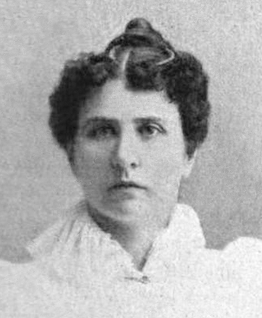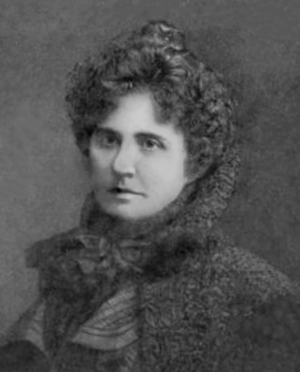Lurana W. Sheldon facts for kids
Quick facts for kids
Lurana W. Sheldon
|
|
|---|---|
 |
|
| Born | Lurana Waterhouse Sheldon April 11, 1862 Hadlyme, Connecticut, U.S. |
| Died | June 11, 1945 (aged 83) Maine, U.S. |
| Pen name | Richard Hackstaff, Stanley Norris, Grace Shirley |
| Occupation |
|
| Language | English |
| Nationality | American |
| Alma mater | Woman's Medical College of the New York Infirmary |
| Genre | novels, poetry, short stories |
| Notable works | "Marion Marlowe" dime novel series |
| Spouse |
Isaac F. Ferris
(m. 1904) |
| Relatives | Jonathan Edwards |
Lurana W. Sheldon (born April 11, 1862 – died June 11, 1945) was an American writer. She wrote many novels, poems, and short stories. She also worked as a newspaper editor. Lurana used different pen names like Richard Hackstaff, Stanley Norris, and Grace Shirley.
Sheldon was very busy and creative. She wrote over a million words in her lifetime! She also said she earned her living in fifteen different jobs. These included bookkeeping, managing businesses, and working in a chemical lab. She was a strong supporter of women's right to vote. She also spoke out against Prohibition, which was a law against alcohol.
Many of Lurana's poems appeared in The New York Times. She became well-known for her connection to that newspaper. She is also remembered for her "Marion Marlowe" dime novel series. One book, My Queen, was special because the main character didn't get married at the end. This was unusual for romance stories back then.
Lurana also had a medical education. This helped her understand people's lives and social issues. In 1915, she gave a lecture in verse called "The Alien." It talked about society and was heard in New York and other places. A poem from this lecture, "The Night Court," was very popular. She wrote many novels, stories, and over a thousand poems. These appeared in almost every major magazine and newspaper in the U.S.
Contents
Early Life and Learning
Lurana Waterhouse Sheldon was born on April 11, 1862. Her hometown was Hadlyme, Connecticut. Her parents were Asa and Christiana Sheldon. Her family had lived in New England for a long time. Her father's ancestor was Jonathan Edwards, a famous religious leader.
Lurana went to public and private schools. In 1882, she started studying at the Woman's Medical College of the New York Infirmary. During her studies, she visited places where poor people, sick people, and prisoners lived. Seeing these difficult conditions made her think deeply about life and society. After six years of studying and practicing medicine, she had to stop due to health problems.
Her Career Journey
Working in Medicine
Lurana spent two years at the Woman's Medical College. She also spent almost seven years helping doctors in hospitals. Dr. James M. Kenniston wrote about her work at the Connecticut Hospital for the Insane. He said she visited to learn how patients were treated. She was very thorough and kind to the patients. They really liked her because she was honest and sincere.
Becoming a Writer
Lurana started working to support herself at age seventeen. She began writing poems when she was ten. But she didn't start earning money from her writing until she was twenty-five. She used her free time to write. Like many writers of her time, she first found success in the New York Mercury newspaper.
Her poem "The Medical Student's Dream" and some other writings were chosen for an exhibit. This was for New York State literature at the World's Columbian Exposition in Chicago in 1893.
By 1900, she had published over two hundred stories. Her funny poems were known by many newspaper editors. From 1900 to 1902, she worked for a big publishing company in New York City. In just one year (1900), she wrote over a million words! A new story from her was on bookstands almost every week.
Lurana wrote war poems for The New York Times and other magazines. She also wrote serious articles that showed her deep thinking. She often published her work using pen names or no name at all. This was partly her choice and partly because of how editors treated writers.
Her writing covered many topics. She wrote articles about freedom of thought, funny pieces for newspapers, ghost stories, and exciting adventure tales for boys. Lurana loved animals very much. She felt strongly that people who mistreated animals should be punished. She also believed that parents should be able to care for their children.
In total, she published seven novels, about two hundred short stories, over a thousand poems, and many articles on science and social topics.
Her Thoughts on Life
Lurana grew up in a traditional religious family. However, she began to question many things. She found answers that made more sense to her through studying science and the ideas of thinkers like Charles Darwin. She believed that "faith," "hope," and "love" were important human achievements. She felt these came from our own minds and experiences, not just from religious beliefs.
She believed that people should be free to choose their own beliefs. She also felt that real help and kindness often came from unexpected places, not always from religious groups. She saw that some people who claimed to be religious were not always honest.
Personal Life
Lurana Sheldon faced health challenges. But she still traveled around the United States, Nova Scotia, and Newfoundland. She felt she was content with little, but found it hard when good work wasn't rewarded. She lived alone and preferred books to social gatherings. She wished that people in power would do more to improve the world.
She didn't like to talk about her difficulties. She once said she was born with "poverty, poor health and ambition." She also described herself as having a strong spirit that didn't like being told what to do. She was determined to live life her own way, even if it meant facing many challenges.
Lurana was a strong supporter of women's rights. In 1916, in Maine, she started the Women's Defense Club. Its goal was to teach American women how to shoot guns for self-defense.
On November 20, 1904, she married Judge Isaac F. Ferris. He was a journalist earlier in his life. Lurana Sheldon died in Maine on June 11, 1945. She did not have any children.
Selected Writings
By Lurana W. Sheldon
- Death to the Inquisitive!: A Story of Sinful Love, 1892
- Is this your God?, 1900
- Whom god hath joined together, and The curse upon progress, 1900
- For Gold or Soul?: The Story of a Great Department Store, 1900
- As we forgive : a romance, 1928
- For Love Or Gold?: A Romance, 1928
- For Love Or Gold?: The Story of a Great Department Store, 1928
By Stanley Norris
- The young showman's triumph, or, a Grand tour on the road, 1903
- The young showman's rivals; ups and downs of the road, 1903
- The young showman's pluck; or, An unknown rider in the ring, 1903
By Richard Hackstaff
- "Tracked by a Pin", The Magnet Library
- Pete, the Breaker Boy, Or, The Young Coal Mine Ferret, 1906
- Bags, the Boy Detective, Or, A Warm Trail, 1907
- Bob, the Shadow, Or, Solving a Double Mystery, 1908
By Grace Shirley: My Queen, A Weekly Journal for Young Women
- The Daisy Chain
- The City Boarder
- Marion Proves her Intuitions
- The Abduction of Dollie
- A Dark Deed
- The Plot of a Villain
- On the Track of the Abductor
- The First News of Dollie
- The Picture on the Poster
- Marion Finds her Uncle At Last
- The Return of Miss Gray
- Marion Discovers Dollie
- The Arrest and Rescue
- Questions & Answers
- Marion Marlowe in Buffalo, or, Betrayed by a rival company
- Marion Marlowe in Chicago, or, Trapped by a lunatic
- Marion Marlowe in Cleveland, or, The mystery of the red rose
- Marion Marlowe in Columbus, or, Accused of a crime
- Marion Marlowe in Denver, or, The tragedy of Pike's Peak
- Marion Marlowe in Indianapolis, or, The adventure of Dr. Brookes
- Marion Marlowe in Omaha, or, Held up by accident
- Marion Marlowe in Salt Lake City, or, A bad deal in Mormon Land
- Marion Marlowe in St. Louis, or, A forger's bold deed
- Marion Marlowe in St. Paul, or, The company's mascot in a double deal
- Marion Marlowe in Washington, or, Meeting the president
- Marion Marlowe's noble work, or, The tragedy at the hospital
- Marion Marlowe's money, or, Brave work in the slums
- Marion Marlowe's skill, or, A week as a private detective
- An interrupted wedding, or, Marion Marlowe as maid of honor
- Marion Marlowe's courage, or, A brave girl's struggle for life and honor
- Marion Marlowe's Christmas Eve, or, The treachery of a factory inspector
- Marion Marlowe's true heart, or, How a daughter forgave
- Marion Marlowe's peril, or, A mystery unveiled
- Marion Marlowe's triumph, or, in spite of her enemies
- Under lock and key, or, Marion Marlowe's last role
- Marion Marlowe's noble work, or, The tragedy at the hospital
- Marion Marlowe's cleverness, or, Exposing a bold fraud
- Marion Marlowe entrapped, or, The victim of professional jealousy
- Marion Marlowe's disappearance, or Almost a crime
- A wonderful secret, or, Marion Marlowe's discovery
- Marion Marlowe's escape, or, A dangerous mistake on the road
- From farm to fortune, or, Only a farmer's daughter
- Marion Marlowe in society, or, A race for a title
- Marion Marlowe on the prairie, or, A thrilling ride across Kansas
- A lover's quarrel, or, Marion Marlowe's deceitful friend
Other Short Stories
- "City Sleighing", The All-Story Magazine, Jan 1909
- "To the Wind", The Cavalier Feb 22 1913
- "Spring Attractions", The Cavalier, Apr 4 1914
- "The Autumn", Munsey’s Magazine, Nov 1914
- "It Might Be Worse!", All-Story Cavalier Weekly, Nov 21 1914
- "First Love", All-Story Weekly, Mar 10 1917
- "The Grand Army of 1918", Munsey’s Magazine, Feb 1918
- "The True Patriot", All-Story Weekly, Mar 2 1918
- "Gun Language", All-Story Weekly, May 18, 1918
- "Counting the Kisses", Munsey’s Magazine, Dec 1919


